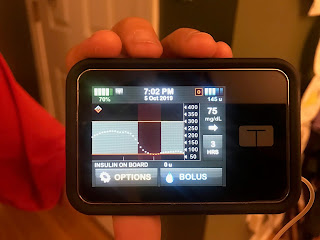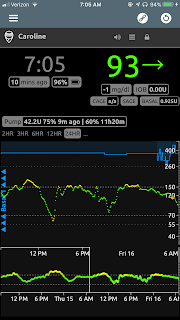And of course it was an observation that I probably was alone in making. I mean who even cares what size snack someone else's kid has? But, because our life revolves around counting carbs for every piece of food to touch our lips, I DO notice things like other people's snacks.
What was really weird was that seeing those bags of goldfish made me feel instantly kind of sad. Just a wave of sad came over me. And I'm totally not one that feels sad often. I'm a glass half -full, look on the bright side, positive-attitude always kind of gal. But my first thought when I saw those goldfish bags was "OMG HOW MANY FREAKING CARBS ARE IN THOSE BAGS? THOSE ARE HUGE BAGS! SO MANY CARBS! SO MUCH INSULIN NEEDED!"
And then I looked at those kids and thought, they have no idea....they don't have to worry about how many carbs are in the bags. Duh. They can eat as much or as little of those bags as they like and NO ONE has to worry about it. Except maybe mom because they might not be hungry for dinner if they eat the whole bag.
And then it made me realize that I can't just give Caroline a GIANT bag of goldfish and not worry about how many stupid carbohydrates are in the bag. Not only that, if I WERE to give her a giant bag of goldfish and I calculated the carbs correctly, I'd have to make her wait to eat them until her insulin started working because injected insulin takes at least 20 minutes to have an affect, especially with that carb-load. A healthy pancreas just works like magic in people without Type 1 diabetes! No timing of insulin required. OH! And then I'd have to guess about how MUCH of that bag she would eat. If I gave her insulin for the whole bag, and then she only ate half, she'd have too much insulin running around in her body that would make her blood sugar go low. So that's always fun, trying to guess how much of a food someone is going to want to eat.
I rarely have these thoughts. Really, I don't. I just do what we have to do and move on. But I thought back to the bliss of the NOT KNOWING. Not knowing about every single thing about what we are eating, when we are eating it, and a million other factors that come into play. That was the time in our lives before a Type 1 diabetes diagnosis. when we could eat quart-sized bags of goldfish crackers and not have a care in the world. Those days were nice, the not knowing days. However, I have to say (I can't help looking at the bright side) HAVING to know also makes you more conscious about what you are putting in your mouth and your body. So there's that. We are probably eating healthier than ever since Type 1. Not that we are perfect by any means (see our latest FroYo outing below!) But we are more aware, and that can't be all bad.
Soooooo, moving on to other things, clinical trial life with the Dexcom G6 and Tandem t:slim with Control IQ has been pretty sweet (no pun intended!). Life just goes on as normal with a few blips here and there. I will say that we are still loving the Dexcom G6 with no fingersticks required and no calibrations. It will be super hard going back to our 670g in a few months and having to do at least 2 (preferably 3) fingerstick calibrations each day. Sigh. Thankful for the amazing technology that we have either way, though! (See, I can't help but be positive!). The t:slim pump with Control IQ is amazing and although it does really the same thing as our 670g, it is less fussy and doesn't need as much attention. Oh and our overnights....amazing. Basically a straight line in range of 90-120 every night. I don't even wake up to check anymore. I just know she's going to be steady and safe. (Except when the pump runs out of insulin...keep reading).
Anyway, here is our Dexcom 24 hour graph from today.
You can see that 1) her pump ran out of insulin around 6:00 AM and no one woke up to the alarms so she just didn't get insulin for an hour or so. Amazing how quickly her blood sugar went up due to lack of insulin for a short period of time. Scary, actually. 2) We went to the FroYo place today and each time we go there (before today,) we have severely underestimated the carbs in the bowl, not given her enough insulin, and she's hit mid 300 blood sugars that linger for hours.
Today I decided I was going to KICK SOME FROYO BUTT and give a crap-ton of insulin right up front. Like A LOT of insulin. More carbs than many people might eat in a day. I knew that she also had soccer later, so I was thinking that even if there was a spike, the activity would bring her down. Have to say that I feel like all things considered, we did pretty well! If I'd been super prepared, I would have made sure she had more insulin working in her system (a pre-bolus) before she sat down to eat. But we didn't go above 250! Next time my goal will be to have a longer pre-bolus and I think it might help eliminate the spike.
A soccer game helped with that spike from the FroYo with ALLLLLL the toppings.
And here's what the pump graph looked like during the game. You can see where it suspended the insulin (nothing we did on our part...the pump did that on its own...it's the red area on the graph that means the insulin was suspended) during her game when it saw her blood sugar was dropping due to her activity. This pump is SMART, y'all ;-). She was 75 and steady when we got home. That's NORMAL and awesome.
Oh one last thing. Our JDRF OneWalk is coming up next weekend. I'm going to link our fundraising site below and if you feel like you want to give a little donation to help people with Type 1 diabetes live a healthier life with better technology and one day help find a CURE for Type 1, you can click on the link below and donate. No donation is too small. If you don't want to donate, it's fine! Just wanted to put it out there just in case! No pressure at all.
Hope everyone has a great rest of their weekend!































